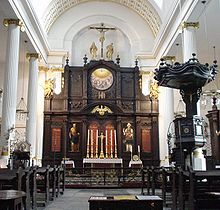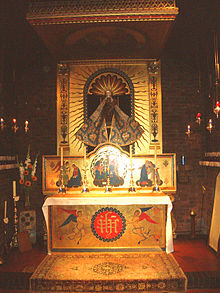Henry Joy Fynes-Clinton

Henry Joy Fynes-Clinton (6 May 1875 – 4 December 1959) was an Anglican priest and a leading
Early life and background

Born on 6 May 1875, Fynes-Clinton was the son of Charles Henry Fynes-Clinton (1835–1915), Rector of
He was the grandson of
In 1899, after leaving Oxford, Fynes-Clinton was a tutor to the Morozov family in Smolensky Boulevard, Moscow.[14] After training at Ely Theological College, he was ordained a deacon in 1901 and a priest in 1902.[15]
Career
Fynes-Clinton served as a curate at St John the Evangelist, Upper Norwood, from 1901 to 1904, at St Martin's Church, Brighton, from 1904 to 1906, and St Stephen's, Lewisham, from 1906 to 1914.[16]
He was curate at
Achievements
Fynes-Clinton was General Secretary of the Anglican and Eastern Orthodox Churches Union

On 6 January 1920, Fynes-Clinton issued a leaflet to all churches and chapels in England in support of Armenians, Syrians and other Christians of the
Fynes-Clinton was delighted by the rejection of the
Fynes-Clinton was one of the founding guardians and a significant benefactor of the
In assessing his influence, Michael Yelton concludes that "Fynes-Clinton was a more important figure than his detractors would have. His opponents looked only at his propensity for founding more and more organisations ... without appreciating his enormously wide international contacts with both Eastern and Western churches, as well as his generally sensible counsel given to all who asked for it and some who did not."[40]
Fynes-Clinton was Master of the Worshipful Company of Plumbers from 1941 to 1943.[41] From 1945 until his death he was an active Governor of Quainton Hall School in Harrow,[42] which was owned by the Walsingham College (Affiliated Schools) Ltd,[43] and represented the Guardians of Walsingham when the school's chapel was dedicated in 1955.[44] Fynes-Clinton remained active until his death at the age of 84.[45]
References and notes
- ISBN 0-85191-174-9; Sorrow and obedience beyond the bounds of Rome, Brindley B.: Catholic Herald, 4 June 1999, Page 12.
- ^ See 1861 census return for 39 Bedford Square, London. C. H. Fynes-Clinton's engineering experience was deployed at Blandford Forum Parish Church, a Georgian building that was built with a small apse, but no proper chancel. In 1895, by the use of jacks and rollers, the apse was ingeniously moved from its original position to one some 30 feet further East on new foundations to provide space for the present chancel. See Blandford Forum Parish Church.
- ^ Burke's Peerage volume 2 (2003), page 2337; See also The Peerage. Birth registered in the first quarter of 1876; baptised by his father on 11 June 1875 (from Blandford Forum Register of Baptisms)
- ^ The Times, 4 August 1894, p. 8, col. D
- ^ The Times, 29 July 1898, p. 10, col. C
- ^ Uncharitably described as "a narrow Evangelical fanatic" by Charles Smyth (see reference below). See St Giles’ Church Cromwell, Fellows of the Royal Geographical Society and Subscribers to the Protestant Association
- ^ Church and Parish - Studies in Church Problems, illustrated from the Parochial History of St Margaret's Westminster, Smyth, C., p. 128: SPCK, 1955. This publication provides a full account of the riot that ensued at St Margaret's Westminster in December 1820, reported in The Times of 11 December 1820, when Fynes Clinton banned an Evangelical lecturer from the pulpit. The subsequent legal case, Clinton v Hatchard (1822), which Fynes Clinton won, became a leading case in English ecclesiastical law; as was the case taken by his great grandson: Rector and Churchwardens of St Magnus the Martyr v. All having interest (1925). Moreover, his obituary speaks of the affection in which he was generally held: "The charity and goodwill of that religion, of which he was a minister, were not to be mistaken. The poor of Westminster will remember the hand that liberally ministered to their wants; and the love of peace and harmony, which guided his actions and threw their grace upon his demeanour, will not soon be forgotten." (The Gentleman's magazine, Volume 142 Part II, 1827, p.570)
- ^ Old and new London : a narrative of its history, its people, and its places by Walter Thornbury, 1873
- ^ Blazon (description) of the family's arms, as used by Fynes-Clinton on his bookplate: argent, six crosses crosslet fitchée sable; on a chief azure, two mullets pierced or; a mullet pierced or for difference
- ^ See Politics of the 4th Duke of Newcastle
- ^ See History of Parliament, Literary Remains and Lives of the Founders of the British Museum by Edward Edwards, p.533-4, 1870 British Museum for different aspects of his career. He was son-in-law of Bishop Henry Majendie and father-in-law of Thomas Gambier Parry (a Tractarian and prominent member of the Cambridge Camden Society and father of Sir Hubert Parry)
- ^ See History of Parliament and Second Reading of the Reform Bill - 4 July 1831. "Mr Fynes Clinton's speech in favour of the amendment was, take it as a whole, the best delivered on his side of the question." (The New Parliament - The Reform Bill in The New Monthly Magazine and Literary Journal, 1831, Part II, p.120, London). Commenting on the Oxford University by election of 1829 at which Inglis defeated Peel, Greville commented (22 February 1829) that "Inglis's committee ... is composed of men not much better than old women, except Fynes Clinton, the chairman".
- ISBN 978-1-60911-758-0.
- ^ The Times, 28 May 1902, p. 4, col. A
- ^ At the time of the 1911 census Fynes-Clinton was living with the family of Capt. Charles Cockburn Talbot RD RNR (son of Major General Robert Talbot RA and brother of Major General Harry Lynch Talbot RMA) and his wife, Beatrice Caroline Talbot (née Eden), at 10 Marlborough Road, Lee, Lewisham. Fynes-Clinton subsequently moved with the Talbots to 27, later 8, Finsbury Square and officiated at the marriage of their son, John Angelo Talbot, in 1921. Beatrice Talbot was a descendant of Sir Frederick Eden Bt and a cousin of Anthony Eden, see Eden family. From the 1930s (as shown in successive Electoral Registers) Fynes-Clinton lived in Westminster.
- ^ Crockford's 1908 and 1932
- ^ The Times, 28 May 1921, p. 13. Pathé News filmed Fynes-Clinton at St Magnus on Palm Sunday 1935, see British Pathé Archived 8 July 2011 at the Wayback Machine
- ^ For obituary by Ivan Young see Walsingham, Cobb, P. (ed), pp 97-98: 1990. See also The Times, 7 December 1959, p. 19 and 12 February 1960, p. 14. A Requiem Mass was held at St Magnus on 8 December 1959.
- ^ Founded by Fynes-Clinton in concert with Canon J.A. Douglas and the Rev R.F. Borough - see A history of the ecumenical movement, Volume 1; Rouse R., Neill S. and Fey, H.E.: SPCK, 1970. The Church Intelligencer (Volume 23, Issue 11, November 1906) expressed its concern in an article entitled A New Disorder in the Church – The Anglican and Eastern Orthodox Churches Union: "Simultaneously with the appearance of the Report of the Royal Commission on Ecclesiastical Discipline, there came into existence a new Ritualistic society, the composition of which is as full of significance as the present crisis in our National Church".
- ^ The Union published annual reports between 1906 and 1914 and a magazine, Eirene, which Fynes-Clinton edited for some years from 1908 to 1914. By 1914 it had approximately 2,000 members in Britain and a branch in the United States. See The Times, 24 October 1908, p. 19, column F for a report of the Union's early activities. It merged in 1914 with the Eastern Church Association, which had been founded at the residence of William Denton at 48 Finsbury Circus on 13 April 1863. Fynes-Clinton remained active in the Anglican and Eastern Churches Association until 1933, when he was ousted from its leadership following his call for reunion with Rome. Godfrey Benson, 1st Baron Charnwood settled the issue in a private conversation with Fynes-Clinton. "He agreed to resign the Hon. Secretaryship, but to continue on the Committee if desired. In a long and, to me, extremely difficult conversation, no man, from whom I profoundly and amiably differed, could have inspired more personal respect in me than he did." (Sobornost incorporating Eastern churches review, Fellowship of St. Alban and St. Sergius, Volume 1 No. 1, 1979). For further information on the Union and Association see Lambeth Palace Library, Annual Review Archived 27 September 2011 at the Wayback Machine
- ^ The Anglican and Eastern Churches: A Historical Record 1914-1921, SPCK, London, 1921. See Anglican and Eastern Churches 1914-21
- ^ Faith Press, 1921
- ^ Founder of the Society of the Faith and the Nikaean Club. See obituary in The Times, 5 July 1956, p. 14, column B and The Times, 13 July 1956, p. 14, column B
- ISBN 978-0-295-95792-0and The Times, 12 June 1916, p. 3, col. C. A further service was held at St Mary-le-Bow in 1918 (see The Times, 29 June 1918, p. 3, col. C).
- ^ The Times, 6 September 1920, p. 6, col. C
- ^ The Anglican and Eastern Churches: A Historical Record 1914-1921, SPCK, London, 1921. See Anglican and Eastern Churches 1914-21
- ^ Holy Wisdom and British foreign policy, 1918-1922: the St. Sophia redemption agitation by Erik Goldstein in 'Byzantine and Modern Greek Studies', Volume 15, 1991, pp. 36-65. See also Give Back Saint Sophia: A Report of the Speeches Delivered at the Opening Meeting of the Crusade for the Redemption of Saint Sophia, held at the Cannon Street Hotel, on January 23rd, 1919 by Athelstan Riley, London: Faith Press, 1919
- ISBN 978-0-312-09809-4
- ^ Lambeth Conference 1920. See also Constantinople and the Lambeth Conference: Report of the Delegation to the Lambeth Conference of the Oecumenical Patriarchate at Constantinople in 'New Blackfriars', Volume 3, Issue 29, pages 251–265, August 1922. For a recent essay on Anglican-Orthodox relations at this time, particularly in connection with Patriarch Meletios Metaxakis's recognition of Anglican orders in 1922, see Anglican Orders and Orthodox Politics by Bryn Geffert: 'The Journal of Ecclesiastical History'(2006), 57, pp 270-300 Cambridge University Press
- ^ SPCK 1916
- Mar Aprem Mooken, 2003, see Visit Of Mar Timotheus To England
- ISBN 1-85311-655-6
- ISBN 978-1-85311-753-4. Fynes-Clinton endowed the chapel in the Shrine Church dedicated to St John and paid for the Shrine's grant of armorial bearings, see Walsingham, Cobb, P. (ed), pp 46-47: 1990 and Grant of Arms.
- ^ The Catholic League 1913-1988, Farmer, R.: London (no date). The work of the Catholic League has been carried forward in more recent years by the Revd Preb Brooke Lunn, whose vocation to the priesthood was encouraged by Fr Fynes-Clinton; see Anglicanorum Coetibus.
- ^ See Church Unity Octave
- ^ The Times, 12 November 1932, p. 14
- ^ Oxford Movement Centenary Tractate No. 8 Part I, Reprinted and Revised 1943
- ISBN 1-85311-655-6
- ISBN 1-85311-655-6
- ^ History of the Worshipful Company of Plumbers, Young A.J., p. 225: privately printed by The Worshipful Company of Plumbers, London, 2000
- ^ Quainton Hall School, The First Hundred Years: 1897-1996, Milner P.: Harrow, Middlesex, 1997
- ISBN 978-1-85311-753-4
- ^ See Quainton Hall School Chapel
- ^ Fr Brooke Lunn recalls that "For the 8 a.m. Mass Fr Fynes would catch the underground from St James Park, near where he lived, to Monument, close by St Magnus. He was in his eighties. His GP had told him that this was too much for him, and when Fr Fynes carried on nonetheless, his GP said: 'Well, you're on your own.'"
